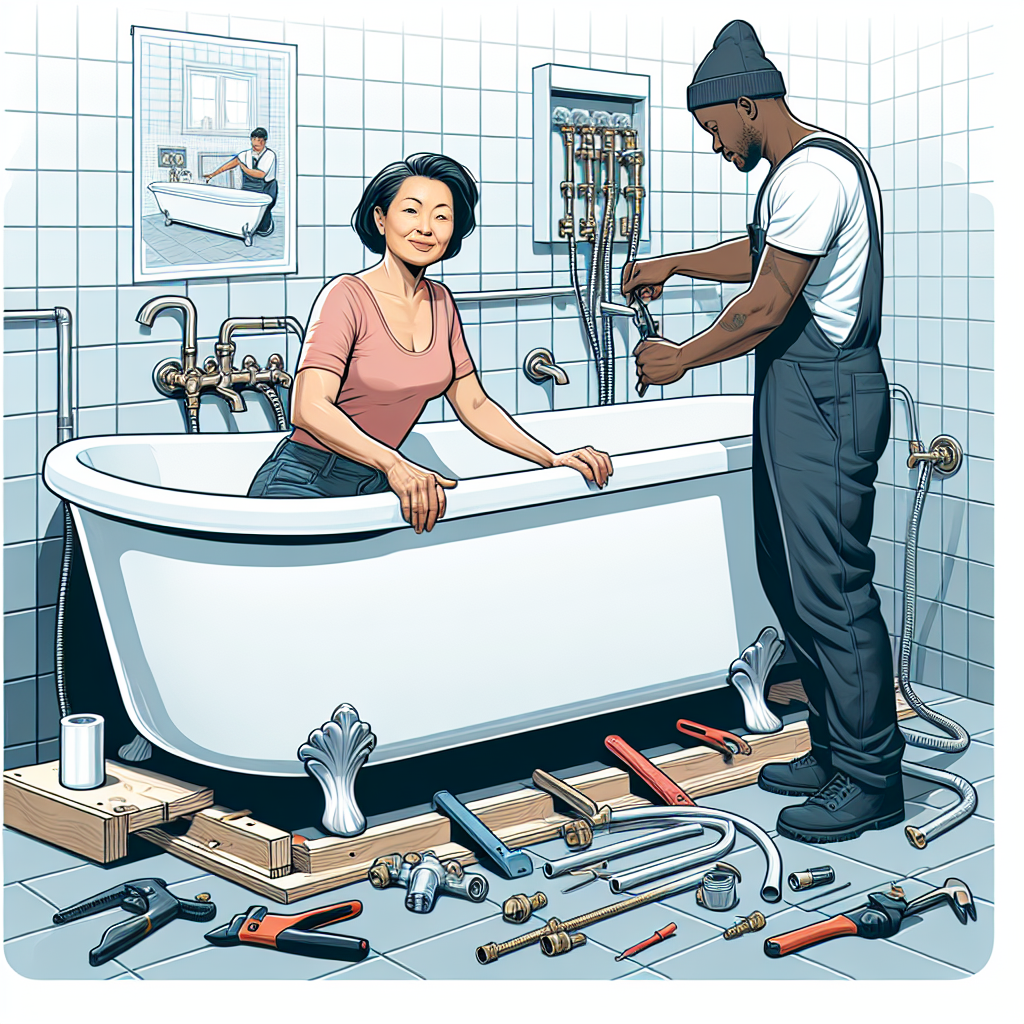Cost-effective Bathtub Installation: A Comprehensive Guide

Installing a bathtub can be a significant investment for homeowners, but it doesn’t have to break the bank. With careful planning and consideration, you can achieve a cost-effective bathtub installation without compromising on quality. In this article, we will explore various strategies, tips, and insights to help you save money while ensuring a successful bathtub installation. Whether you’re remodeling your bathroom or building a new home, this guide will provide valuable information to make the most of your budget.
Benefits of a Cost-effective Bathtub Installation
Before diving into the details, let’s first understand why a cost-effective bathtub installation is worth considering. Here are some key benefits:
- Savings: By opting for cost-effective solutions, you can significantly reduce the overall expenses of your bathroom renovation or construction project.
- Increased Value: A well-installed and aesthetically pleasing bathtub can enhance the value of your home, making it more appealing to potential buyers in the future.
- Improved Functionality: A cost-effective installation doesn’t mean compromising on functionality. With the right choices, you can have a bathtub that meets your needs and provides a comfortable bathing experience.
- Enhanced Aesthetics: Even with a limited budget, you can achieve a visually appealing bathroom by making smart choices in terms of materials, finishes, and design.
Factors Affecting Bathtub Installation Costs
Before embarking on a cost-effective bathtub installation project, it’s essential to understand the factors that can influence the overall costs. By considering these factors, you can make informed decisions and find ways to save money without compromising on quality. Here are the key factors to consider:
1. Type of Bathtub
The type of bathtub you choose can significantly impact the installation costs. There are various options available, including:
- Standard Alcove Bathtub: These are the most common and affordable bathtubs, designed to fit into a three-wall enclosure.
- Freestanding Bathtub: These bathtubs offer more design flexibility and can be placed anywhere in the bathroom. However, they tend to be more expensive.
- Corner Bathtub: Ideal for smaller bathrooms, corner bathtubs can save space but may require additional plumbing work.
- Whirlpool or Jetted Bathtub: These luxurious options provide a spa-like experience but come with higher installation and maintenance costs.
Consider your budget and requirements to choose the most suitable type of bathtub that aligns with your cost-effective goals.
2. Material and Quality
The material and quality of the bathtub can significantly impact both the upfront and long-term costs. Common materials include acrylic, fiberglass, cast iron, and porcelain. While acrylic and fiberglass tend to be more affordable, they may not be as durable as cast iron or porcelain. However, it’s important to strike a balance between cost and quality to ensure a long-lasting and cost-effective solution.
3. Plumbing and Installation Complexity
The complexity of the plumbing and installation process can affect the overall costs. If your bathroom layout requires extensive plumbing modifications or if you’re installing a bathtub in a new location, the costs may increase. It’s advisable to consult with a professional plumber to assess the complexity and plan accordingly.
4. Additional Features and Accessories
Additional features and accessories, such as showerheads, faucets, grab bars, and built-in storage, can add to the overall costs. While these features enhance the functionality and aesthetics of your bathtub, it’s important to prioritize and choose cost-effective options that align with your budget.
Strategies for Cost-effective Bathtub Installation
Now that we understand the factors influencing bathtub installation costs, let’s explore some strategies to achieve a cost-effective installation:
1. Plan and Research
Proper planning and research are crucial to ensure a cost-effective bathtub installation. Take the time to explore different options, compare prices, and read customer reviews. Look for reputable suppliers and contractors who offer competitive prices without compromising on quality. By being well-informed, you can make informed decisions and avoid unnecessary expenses.
2. Opt for Standard Sizes
Choosing a standard-sized bathtub can save you money on both the purchase and installation. Custom-sized bathtubs often require additional labor and materials, increasing the overall costs. Standard-sized bathtubs are readily available and can fit into most bathroom layouts without the need for extensive modifications.
3. Consider Refinishing or Reglazing
If you have an existing bathtub that is in good condition but looks worn out, refinishing or reglazing can be a cost-effective alternative to replacement. These processes involve repairing and recoating the bathtub’s surface, giving it a fresh and new appearance. Refinishing or reglazing is significantly cheaper than purchasing a new bathtub and can save you both time and money.
4. DIY vs. Professional Installation
While DIY installation may seem like a cost-effective option, it’s important to assess your skills and experience before taking on such a project. Improper installation can lead to costly repairs and potential water damage. In some cases, hiring a professional contractor may be more cost-effective in the long run. Consider your abilities and the complexity of the installation before making a decision.
5. Energy-efficient Options
Investing in energy-efficient bathtubs can help you save money on utility bills in the long term. Look for bathtubs with good insulation and features such as low-flow faucets and showerheads. These options not only reduce water consumption but also save energy required to heat the water.
Frequently Asked Questions about Cost-effective Bathtub Installation
1. What is the average cost of bathtub installation?
The average cost of bathtub installation can vary depending on several factors, including the type of bathtub, materials used, complexity of plumbing, and additional features. On average, homeowners can expect to spend between $1,000 and $5,000 for a standard bathtub installation.
2. Can I install a bathtub myself to save money?
While it’s possible to install a bathtub yourself, it’s important to consider your skills and experience. Improper installation can lead to costly repairs and potential water damage. If you’re confident in your abilities and have the necessary knowledge, you can save money by opting for a DIY installation. However, for complex installations or if you’re unsure, it’s advisable to hire a professional contractor.
3. Are there any cost-effective alternatives to replacing my bathtub?
If your existing bathtub is in good condition but looks worn out, refinishing or reglazing can be a cost-effective alternative to replacement. These processes involve repairing and recoating the bathtub’s surface, giving it a fresh and new appearance. Refinishing or reglazing is significantly cheaper than purchasing a new bathtub and can save you both time and money.
4. How can I save money on plumbing costs during bathtub installation?
To save money on plumbing costs during bathtub installation, consider the following tips:
- Choose a bathtub that aligns with your existing plumbing layout to minimize modifications.
- Opt for standard-sized bathtubs that fit into most bathroom layouts without extensive plumbing work.
- Consult with a professional plumber to assess the complexity and plan accordingly.
- Consider energy-efficient options that may qualify for rebates or incentives, reducing the overall costs.
5. How can I enhance the aesthetics of my bathtub without spending a fortune?
To enhance the aesthetics of your bathtub without breaking the bank, consider the following:
- Choose cost-effective materials such as acrylic or fiberglass that offer a wide range of design options.
- Focus on small details such as faucets, showerheads, and accessories to add a touch of elegance.
- Consider refinishing or reglazing your existing bathtub to give it a fresh and new appearance.
- Opt for affordable yet stylish tile or surround options to complement your bathtub.
Summary
Cost-effective bathtub installation is achievable with careful planning, research, and smart choices. By considering factors such as the type of bathtub, material quality, plumbing complexity, and additional features, you can find ways to save money without compromising on quality. Strategies such as proper planning, opting for standard sizes, refinishing or reglazing, and considering energy-efficient options can help you achieve a cost-effective bathtub installation. Remember to consult with professionals, compare prices, and prioritize your needs to make the most of your budget. With the right approach, you can enjoy a beautiful and functional bathtub without breaking the bank.

